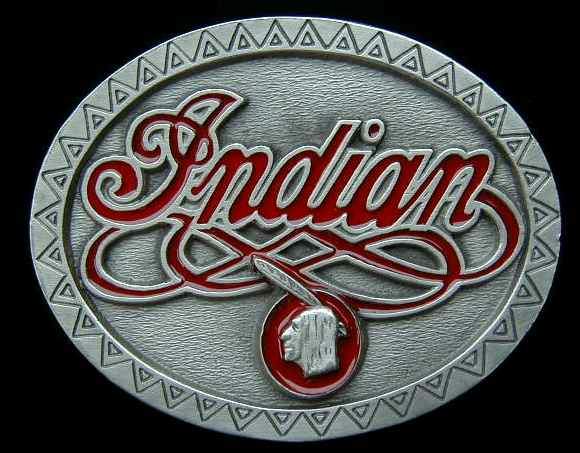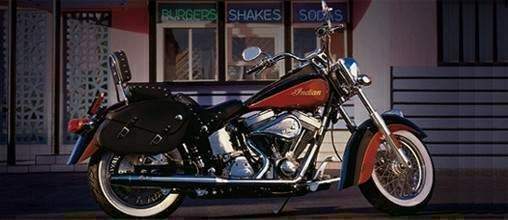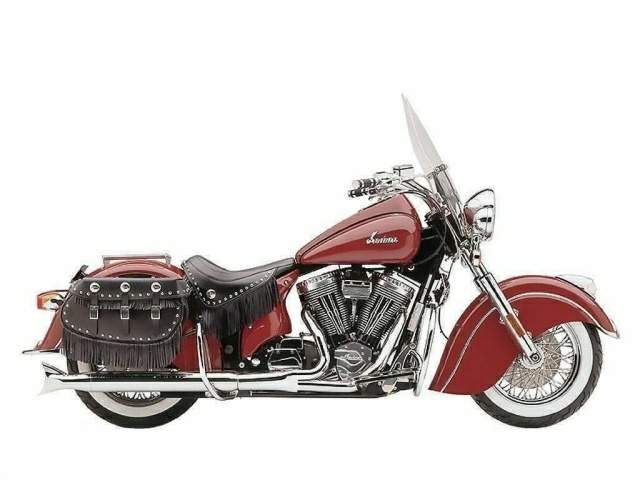by Victor
Wanchena and Sev Pearman
It is a 45
year long story with enough twists and bends to make your
head spin. I refer to the saga of Indian Motorcycle Company.
Once the industry leader in motorcycles, by the early 50's
they had fallen on hard times. Low profits had forced the
company to close its doors. The years saw the marquee fall
into a trading game. The only real viable asset left to
Indian was their name and the all too famous script logo. The
rights to the name traded hands and even ended up for a while
on the Royal-Enfields produced in the country of India.
The story
gets a little foggy after Enfield. The name eventually was
used by several groups that tried to resurrect the Indian
brand, but all failed horribly. That is until now. In 1998,
all the court battles over the name finally came to an end.
The result was a merger of several companies into the Indian
Motorcycle Company that we know today. Starting simple, they
released a limited edition Chief for 1999. The following
years have seen the release of two additional models. First
the Scout and now the Spirit.
That brings
us to this month's test ride, a 2001 Indian Scout. This
second model in the Indian lineup is patterned to reflect
what the original Scout role was. It is lighter, faster and
handles better than its big brother the Chief. But can it
live up to all the expectations and carry all the baggage
that accompanies the legendary name that resides on its tank?
Read on and find out.
The time
arrived for me to pick up the Scout from it's gracious owners,
Thomas Indian Motorcycles. What a perfect day. The weather
was finally in the sixties and the sun was shining bright. I
strolled up to the bright yellow bike and took a good long
look. This bike is an attention getter. The color itself was
enough to draw your attention and the attention of everyone
else in the near vicinity. After spending a few moments to
get familiar with the bike, I hopped on and thumbed the beast
to life. The starting procedure was basically the same as any
other bike. Open the choke, hold in the clutch, crack the
throttle and hit the start button. The 88 cubic inch motor
spun to life with no hesitation. A few moments to warm up and
I was on the road.
The heart of
the Scout is an 88ci (or 1442cc for you metric types) S&S
v-twin. For those not familiar with S&S, they are the one of
the largest suppliers of direct replacement parts for Harley
motors. They make everything to the point where you can
assemble an entire Harley "clone" motor out of S&S parts. And
that's exactly what Indian does. They special assemble the
motors to their specs in their Gilroy, California factory.
The motor puts out a claimed 75 horsepower and an unspecified
amount of torque (we guess around 80 foot pounds) and though
unverified, it felt accurate. Otherwise the motor is very
similar to the H-D Evo that has been a staple in the American
cruiser diet for years. Before you get too hard on Indian's
case for not having their own motor, remember that to develop
a new motor from the ground up cost a minimum of 10 million
dollars. You need to sell a lot of bikes to recoup that kind
of cash and for a start up company it is always wiser to
spend your capital frugally. For the record, Indian has
stated that they are working on a motor of their own.
The
transmission is a 5-speed copy of the H-D unit built by
Rev-Tech. It works well and has a very positive feel when
shifting, but requires a fair amount of effort. The primary
drive as well as the secondary drive are both belt driven. If
you aren't familiar with belt drive, it has its pros and cons.
It is light, quiet and requires little maintenance, but it
also can fail suddenly if the belt is torn and is impossible
to repair roadside. The clutch is a dry system that I find no
fault with, though riders used to wet clutches may need some
time to adapt. It should also be noted that the newest Indian
model, the Spirit, has a transmission and primary drive
system of Indian's own design. It should find its way to all
the models in the Indian line by next year.
The running
gear of the Scout is quality merchandise. I was thoroughly
impressed by the fit and finish of the bike. The choices of
paint colors was very nice varying from red and yellow to the
ever present black. The Indian motif is found throughout the
bike from the arrowhead shaped cutouts in the frame to the
light-up "war bonnet" emblem on the fender. The suspension is
adequate boulevard cruising not much more. The switch gear is
also of H-D descent and is simple except for the turn signals,
which always confuse me. I understand pushing left to turn on
the left blinker but the whole push both to turn it off
continued to fluster me. I often would hold both buttons down
too long thus turning on the hazards.
On the plus
side, Indian has a couple of impressive safety features.
First off, the brakes are top notch. They were not only
strong but also very linear which equals good control.
Despite having only a single disc front and rear, the brakes
on the Scout felt as good as many sport bikes. A far cry from
the tiny drums on the Indians of old. The other neat safety
feature was the fact the rear turn signals were wired to both
flash three times when you hit the brakes. This did wonders
to make the Scout highly visible to any one who approaches
from the rear. A more poetic MMM staffer referred to it as
being "visually arresting".
Now I have
never described my self as a "righteous bro in the wind" but
I immediately felt comfortable on the Scout. As I cruised
around town I discovered just how much attention a bike like
this gets. People everywhere were giving me the high sign,
running across parking lots to talk with me about the bike.
Two kids pedaling by on bikes even ran into one another while
the bike was parked. I felt like was in a parade.
The Scout
did hold a couple of surprises for me. First, I never
expected it to handle as nicely or have even half the
cornering clearance that it has. I would not describe the
handling as sporty but the Scout does let you lean in the
corners, which is more than can be said for a lot of cruisers.
The other surprise was how much vibration can come from a
solid mounted v-twin. The Scout does vibrate enough to make
you a little surly by the end of the ride.
In all, I am
glad to see Indian doing as well as they are. The Scout is a
well put together machine built from high-end components.
Those parts coupled with relatively low production volume do
mean that you pay plenty for a Scout. The MSRP is about 19
thousand. But Indian has had steady sales and have positioned
themselves well for the future. They are definitely not just
making another H-D clone. The Scout is a unique machine
befitting its 100 years of heritage.
by Sev
Pearman
I'm cursed.
Every time we get a heavyweight cruiser to review, it snows,
and our time with the beautiful Indian Scout was no different.
I'm not reviewing another big V-twin unless it is in August.
I ride on
average 10,000 miles a year, and test ride several bikes
annually. I have never noticed more attention, gawkers and
thumbs up while on a production bike than during my time with
the Indian Scout. Everywhere I went, people would emerge from
their snow caves and ask questions. One guy passed us,
stopped his truck and actually ran over to the bike. If you
want to make a statement, get yourself an Indian Scout.
The
resurrected Indian Motorcycle Company came out of the legal
ashes of several fly-by-night carpetbaggers as well as the
merger of "clone" builder California Motorcycle Company and
the American Indian Motorcycle Company. Confused? We are too.
Essentially
what you have is respected big-twin builder CMC entering into
a new partnership, to build H-D Evo clones under the reborn
Indian trademark.
For those of
who have been in a CZ riding coma since '62, several
companies sprang up in the 90's to fill the big cruiser
vacuum created when H-D couldn't, some say wouldn't, meet
demand.
Because of
the extensive after-market, it is possible to build a
complete "Harley" out of non-H-D parts. These "clone"
companies such as Big Dog, Illusion, California Motorcycle
Company, etc. would assemble complete bikes to the customers
specifications, with a shorter wait than for a stock Harley,
at a comparable price to a mildly customized Harley. At least
that is the way it is supposed to work.
When the
Indian trademark began to emerge from its legal coffin, CMC
aligned itself with AIMC, and in 1999 began to produce the "new"
Indian Chief. In 2001, the Indian Motorcycle Company offers
the Chief, the all-new Spirit, and the Scout, tested here.
Whether or not these are Harley-Davidson clones in different
clothes I'll leave to the "Enthusiast Philosophers."
What you
have is a 45-degree S&S V-twin boasting 88 cubic inches. Like
the H-D Evolution motor it is based on, it spins one camshaft
and push rods. Carburation is by the tried-and-true (read:
traditional) S&S E-type. It flows more fuel than a Keihin,
which helps the motor make a little more horsepower.
In addition
to the final drive, the primary is also a belt. The clutch is
dry. This means no oil level to monitor or change as well as
quieter operation. Under fire, we noticed the friction zone
to be relatively narrow, but workable. I'll gladly trade the
clutch's "feel" for one-less maintenance chore.
Tranny is a
Rev-Tech 5-speed, one-down, four-up. This is a quality unit
made by an established company. Shifting, while not GSX-R
precise, is very tight for a big twin. This is made even more
remarkable due to the Scout's forward controls.
Forward
controls tend to be sloppy for two reasons. One, they add
linkage between the gearshift and transmission, which adds
play; and two, you lose the power of your thigh muscles to
help change gears.
While we
could find no false neutrals between gears, I found it hard
to find neutral from second, while either rolling or stopped.
I usually had to go down into first and then ease on up from
there. The gear oil was undoubtedly thickened with temps in
the low 30's, and tranny action did get better as
temperatures climbed. This is one of those things that either
go away during break-in, or the rider simply learns to
compensate.
I have less
than 5,000 miles in total on big twins, but "The Faithful"
tell me the shifting technique can be learned; that it comes
with experience. It's up to the potential owner to decide if
she/he wants to surf this particular learning curve.
The clutch
is cable-activated and is robust. It requires a hefty pull,
which could become a chore in downtown Sturgis traffic.
Combine highway speeds and that sweet belt-primary however,
and it is one tidy system, consistent and fade-free.
Both clutch
and brake levers are non-adjustable. Even with the pronounced
doglegs, it is quite the reach, even with my XXL-sized gloves.
This is no doubt one of the many areas a custom cruiser buyer
will sacrifice practicality for style. This ain't all bad. If
we ignored style completely, we'd all be riding brown '79
CX-500s with a milk crate bungeed to the back.
 The
brakes are phenomenal. Period. Both wheels spin single discs
pinched by polished 4-piston calipers carved from billet
aluminum. The lever feel was linear and progressive. Squeeze
harder, stop sooner. I was unable to lock up the rear wheel
due, again, to the non-ergonomic forward controls. While it
is safer to avoid skids in general, I'd rather a little more
control through my feet. I guess I've got just too many miles
on BMWs.
The
brakes are phenomenal. Period. Both wheels spin single discs
pinched by polished 4-piston calipers carved from billet
aluminum. The lever feel was linear and progressive. Squeeze
harder, stop sooner. I was unable to lock up the rear wheel
due, again, to the non-ergonomic forward controls. While it
is safer to avoid skids in general, I'd rather a little more
control through my feet. I guess I've got just too many miles
on BMWs.
Another
surprise? The ample cornering clearance. I was unable to
ground any parts at all, despite generous cornering speeds
and my 230 lbs. of shock compression. No doubt the raised
forward controls bought a few degrees of lean, as did the
tastefully tucked twin right-side exhausts. It'd be
interesting to compare the Indian Scout to Victory's 92 SC.
The ride is
the typical big cruiser. Park your ass in the seat, put your
feet forward, and try to suppress your silly grin with the
mandatory affected sneer. Feet forward may be fine for
extended freeway cruising, but I quickly grew tired of the "Stairmaster
routine" at every stop while in town. Did I mention that I am
a traditional footpeg guy?
It's just as
well, as I got butt-burn as the tank went to reserve. With
but 3.5 gallons capacity, the potential for high-40's economy
gives you, on a good day, a range of St. Paul - Duluth. Your
actual mileage may vary.
Instrumentation is the traditional on-the-tank placement that
cruiser riders demand. Speedo, odo and five idiot lights,
that is it.The idiot lights are an example for all of
motorcycling--they can be seen at any angle, even in direct
sunlight. This is one of the many pleasant surprises on the
Scout
In an
obvious attempt to distance themselves from the clone label,
the company has adorned the bike with at least twelve logos.
From the signature fender light to the beautiful embossed
script on the mufflers, she's all Indian. Kinda like your
high-school neighbor with the green-glo hair--nice kid, but
he's tryin' too hard. This is reminiscent of Triumph's return
ten years ago. Their earliest bikes were plastered with "Made
in England & Union Jack stickers.
One item
without question on the Indian is the outstanding fit &
finish. The paint, a high-chroma yellow (Yellowstone in
corporate-speak) is lustrous and simply gorgeous. No orange
peel here. The plentiful chrome and polished aluminum bits
are equally beautiful
Any
self-respecting cruiser company stacks the deck with a ready
supply of bolt-on goodies. Indian has their own line of
windshields, saddlebags and the like, as well as a huge
variety of chrome gee-gaws. Plus, being a clone and since the
Indian "shares some characteristics with other large
displacement domestic twins", there is a vast sea of
aftermarket parts at the ready. Whatever you wish to do,
whatever the look, the market is ready for your Visa.
Grumbles?
Well, the horn is laughable, even by motorcycle standards.
Whether or not this is a supplier quality problem or merely a
crusty ground wire on this particular machine we don't know.
You are
spending almost 20-huge for this machine. Is it worth it?
That depends on how much you like talking to strangers and
the patience of your riding partner. 'Cuz you will be talking
to folks at every stop, and it'd be pretty hard to ride this
alone.
I can think
of a lot of things I'd do with that kind of cake, but it sure
would be fun to grab a set of bags and plan a trip. That and
I'd see about a set of snow tires...





